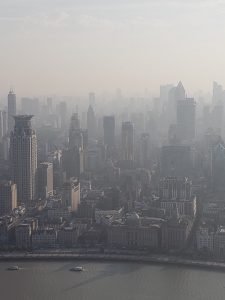How do COVID-19 and climate change relate?

This year, billions of people across the globe went into self-quarantine to avoid COVID -19. People stopped driving to work, businesses shut down, and international borders closed. All of these activities emit tremendous amounts of carbon dioxide, and other greenhouse gasses, that contribute to climate change. See here for more information about greenhouse gasses.
This got me wondering, how has this drastic change in our lifestyle impacted climate change? Well, according to a study at Stanford, it’s estimated that daily global carbon dioxide emissions decreased by approximately 17% by early April of 2020 and that global emissions will decrease by 4-7% this year. That may not seem like a lot, but it is the biggest decrease in greenhouse gasses since World War II.
However, it is incredibly clear that this decrease is unsustainable in the long run. Encouraging people to stay at home and limit public interaction is not the way to solve climate change. People need to go back to work, businesses need to re-open, borders will open, and people will continue traveling.
A New Norm?

In the past, emissions have rebounded after economic downturns, with some exceptions. But, will we ever go back to how it used to be before COVID -19? Or, could this once -in- a- generation pandemic change our lifestyle for good? What if telecommuting becomes more accepted? If employees telecommute just one day a week, they will greatly decrease their greenhouse gas emissions.
- For example, if someone drives a car that gets 25 mpg[1], for 30 miles[2] to get to and from work, they will emit approximately 124 pounds of carbon dioxide each week into the atmosphere[3].
- So, if a million people worked from home 1 out of 5 days a week, that would save about 25 million pounds of carbon dioxide from being emitted each week.
- That is equivalent to the carbon sequestered by 14,809 acres of US forest in one year[4], which is an area a little less than the size of the City of Sarasota.
All in all, only time will tell if this global pandemic will have lasting impacts on our lifestyles and climate change.
Climate Change and Disease

The Spread of Mosquitoes
While there is no direct evidence that climate change is impacting the spread of COVID- 19, climate change can influence the spread of diseases in general. As the Earth heats up and weather patterns change, some disease spreading insects, such as the mosquito, will have more places to call home, thus, increasing the possible spread of disease. This type of migration is happening today. An infectious disease scientist at the Boston Children’s Hospital found that the Aedes Aegypti mosquito, known as the yellow fever mosquito, has spread northward at about 150 miles per year in the United States.

Air Pollution
Air pollution can also increase the impact that a disease has on society. A new study from Harvard Chan School of Public Health states that “people who live in places with [worse] air quality are more likely to die from COVID-19 even when accounting for other factors that may influence risk of death such as pre-existing medical conditions, socioeconomic status, and access to healthcare”. This disproportionately impacts vulnerable populations. Overall, the effects of climate change on disease is a problem that we can no longer ignore.
References and Notes
[1] The average miles per gallon in the United States was 25.1 in 2018 according to the EPA: https://www.epa.gov/automotive-trends/highlights-automotive-trends-report
[2] The average commute to and from work is 30 miles: https://www.nrc.gov/docs/ML1006/ML100621425.pdf
[3] Calculated using the EPA’s Carbon Footprint calculator,https://www3.epa.gov/carbon-footprint-calculator/, assuming everyone performs regular maintenance on their vehicle. Calculated assuming there are two people in the household with the zip code 34231. If your car gets 25 MPG and you drive 30 miles for 5 days a week (150 miles/week) you will emit 6,199 lbs of CO2 annually, according to the EPA calculator. 6,199/ 50 = 124 lbs of CO2 emissions weekly. Calculated using 50 weeks instead of 52 weeks to account for holidays and sick days. To get the amount of emissions one would emit daily, calculate 124/5 = about 25 lbs of CO2 per day. I divided by 5 since we are only looking at workdays. Therefore, if one million people worked from home one day a week, 25 million pounds of CO2 would be saved each week.
[4] Calculated using the EPA’s Greenhouse Gas Equivalency calculator at https://www.epa.gov/energy/greenhouse-gas-equivalencies-calculator for 25 million pounds of CO2.
 0
0
